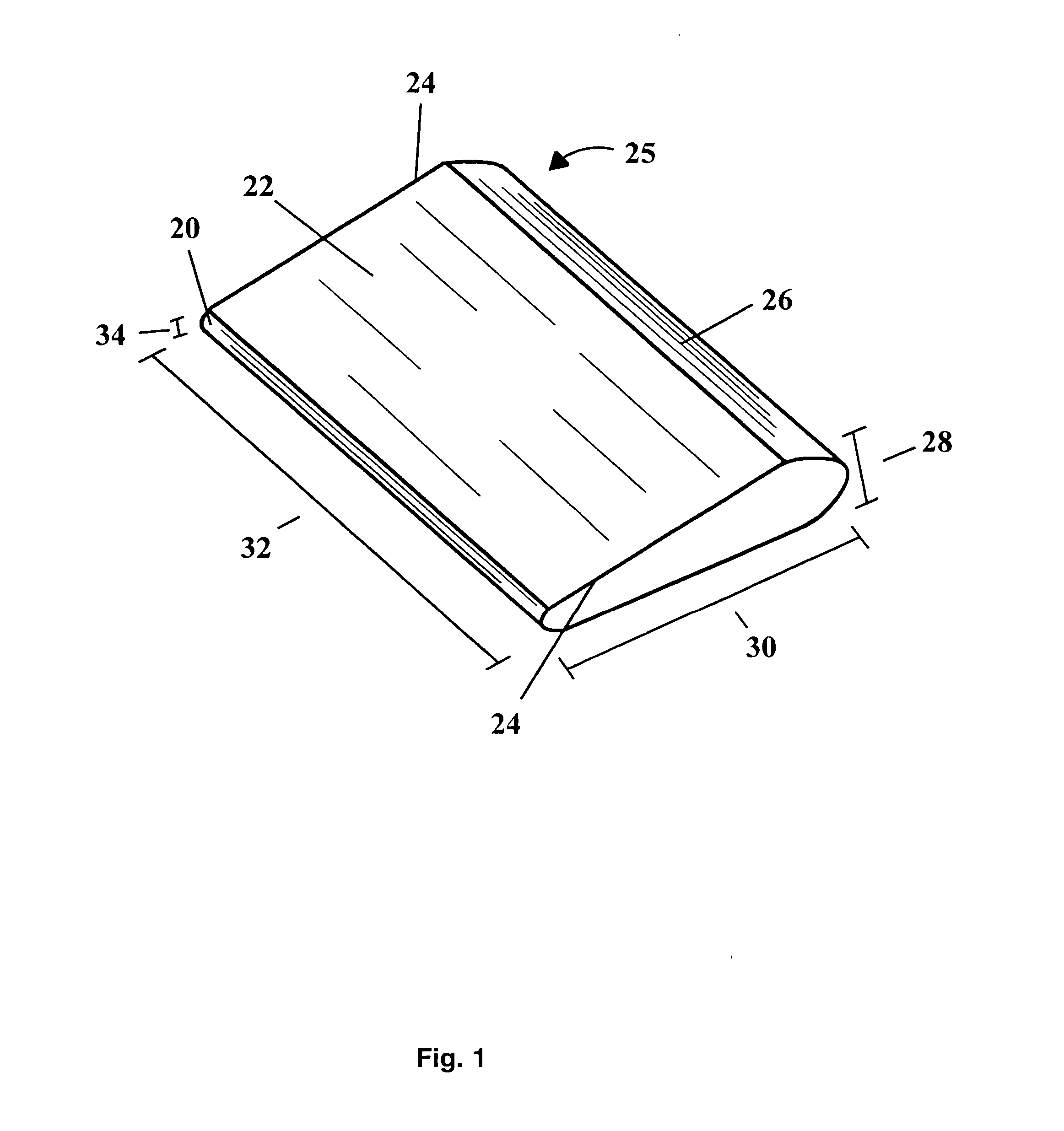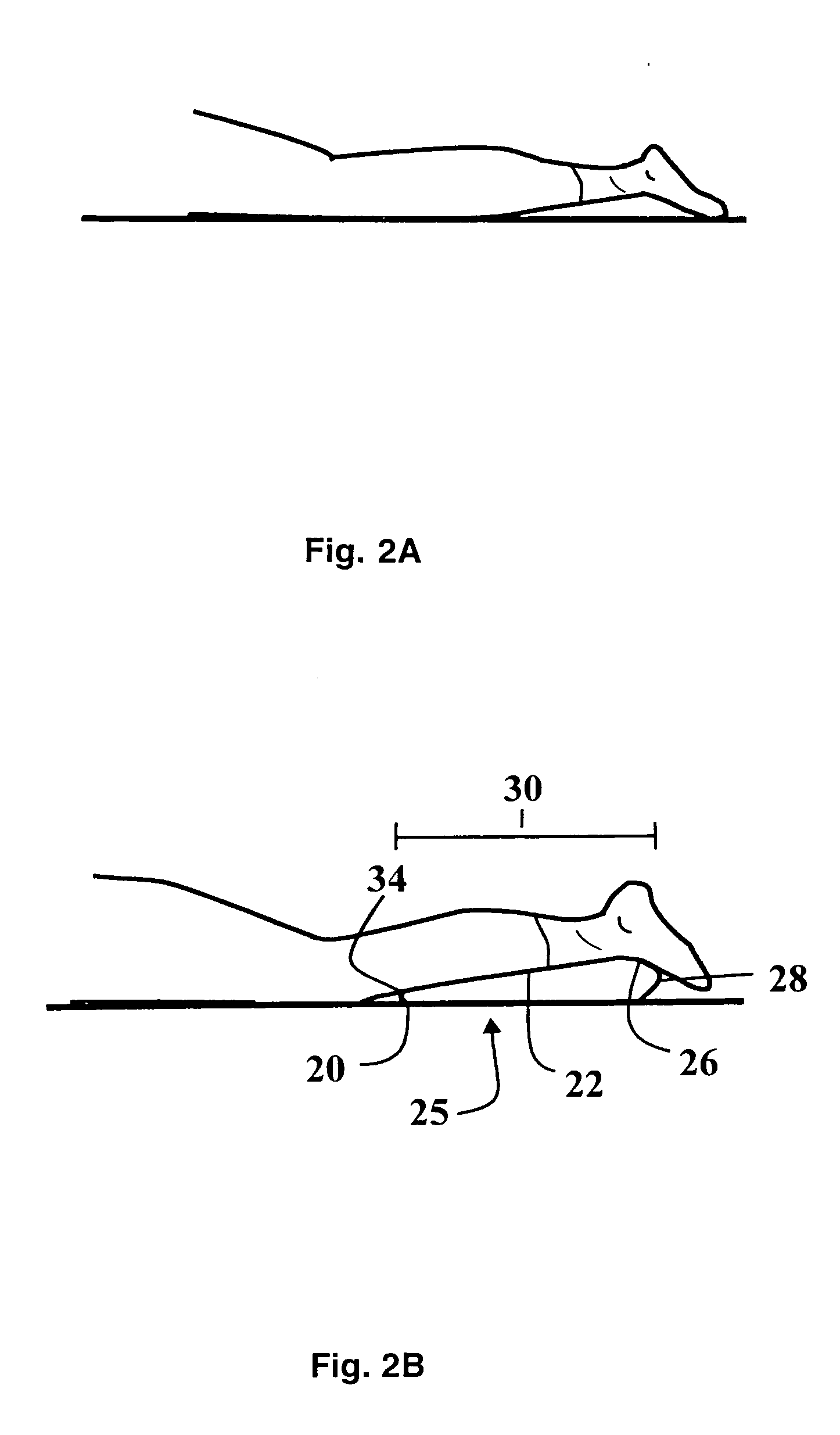Furthermore, within each of these three main resting positions, there are varying degrees of positioning that also lead to the same or similar problems.
For each of these main resting positions, there arise different issues with which to contend, all of which have been associated primarily and more specifically with back, hip, or neck discomfort.
In part, these discomforts are caused by the incongruencies between the flat resting surface and the natural curvatures of the body, combined with the effects of gravity.
For example, while resting on one's side, the leg that is non-adjacent to the resting surface, the“top” leg, will drop to the resting surface resulting in a downward pull on the top of the hip or lower-back, whereby potential discomfort is caused in both areas.
Also, it will always be the case with this resting position that there is an uneven or asymmetrical distribution of weight on the body from the affects of gravity, which can lead to discomfort, unease, or poor muscular and skeletal alignment.
There is no way to totally resolve this situation, unless the affects of gravity on the body are stopped altogether.
Some of the current support means accomplishes this, but many do not provide support for the lower part of the leg.
Thus, the lower leg will still pull down on the area above the
knee region, which potentially causes a problem similar to the original one, albeit it possibly with less intensity of
resultant discomfort.
There still remains a great potential for
resultant discomfort on the knee,
thigh and
hip region instead of the lower back under such circumstances.
It is also clear that much of the prior art does not allow for versatility in use for other areas of the body, inter alia, head, neck, back, hips, thighs, ankles, feet, and limits maneuverability of the user, while being offered as a single unit design.
While resting on one's back, the primary discomfort is found in the lower back region, with potential discomfort all the way up into the neck.
This natural body curvature prevents an even distribution of
body weight on the resting,
support surface, which subsequently leads to muscular or skeletal discomfort.
Many means of support in the current art provide such support, but lack versatility of use or are very bulky in size, which takes away from the maneuverability of the user.
Furthermore, when not in use, storage of such items is aesthetically unpleasing or inconvenient for the user.
The shin, foot, and
ankle areas are incapable of resting flat or evenly along the resting surface.
This happens due to the inability of most persons to fully straighten the
ankle in respect to the shin.
This leads to eventual discomfort in the top of the delicate toes, feet, or ankles.
The discomfort is alleviated in the foot area, but new discomforts arise in the hips or lower-back due to
asymmetry in
body positioning and
weight distribution or to the unnatural position when both legs pivot out at close to a 90 degree angle starting at the ankles.
Unfortunately, this only increases the
asymmetry of
body positioning with greater likelihood of discomfort and potential bodily pains with every inch of leg movement upward, because the amount of
asymmetry is increased as the leg moves up and away from the body, along with an increased lack of support with upward
torso elevation away from the
support surface.
The vicious cycle continues with tossing and turning all night, which takes away from the quality of rest the body needs, all with discomfort and potentially resultant bodily pains within and upon rising from the resting context.
Head or neck discomforts are associated with all of these aforementioned resting positions.
The current field has found numerous ways of supporting the
head and neck in differing positions to resolve potential discomfort, but there are drawbacks that pertain to versatility of the head support overall, which essentially locks the user into one or two resting positions alone.
An example of this is U.S. Pat. No. 6,345,401 that discloses a support pillow having two curved sides for a person to rest either on his or her side or back, but lacks the versatility to be used while resting on the
stomach.
This support pillow also lacks ‘flippability’ for equal use on either lateral side of the
support surface and can only be used on one side.
These prior support articles have limited areas of body coverage and lack the proper intervention point(s) whereby a more peaceful period of rest can be accomplished, while allowing for versatility of use and maneuverability of the user and while simultaneously maintaining desired
comfort levels.
Further drawbacks include bulkiness of the support articles, expense of manufacturing, which equals end-user expense, inadequate support, or lack of ease in storing the support object when not in use.
Both inventions provide a limited amount of maneuverability by the users, i.e., a user cannot rest in a
diagonal position in respect to the mattress itself.
Other obvious drawbacks to both of these examples of mattresses are the expense, bulkiness of the unit and lack of versatility in use.
With respect to back of the
thigh elevation for lower-
back support, U.S. Pat. No. 4,432,108 is limited in that the support continues down toward the
ankle area thereby losing the leg's potential for side-to-side pivoting, as well as locking the user into one resting position alone.
The size of both units is very large and bulky, and essentially restricts the range of movements of the user.
U.S. Pat. Nos. 5,797,153 and 5,878,453 both exemplify attempts to solve the lower-back issue through
thigh elevation support means, but both are bulky units that limit the user's maneuverability on the resting surface and lack versatility of use, in particular, fully resting on one's
stomach.
This adds to complexity of use and makes it more probable that the user will be aroused from an otherwise potentially more restful state.
In respect to resting on the side, this item only supports the thighs and does not allow the user to support the entire leg, which leads to potential discomfort, as described above, in the knee and hip areas.
This support means also lacks the versatility of use while resting on the stomach, and as also mentioned above, teaches away from resting on the stomach.
The support pillow is not designed to support and align parts of the body other than the
head and neck.
Specifically, the prior art is deficient in a multi-use support pillow combining an inclined support surface with supportive ends and side edges to provide the proper support and body alignment for those who choose to rest on the side, stomach, back, or throughout the range of different possible resting positions therebetween.
 Login to View More
Login to View More  Login to View More
Login to View More 


